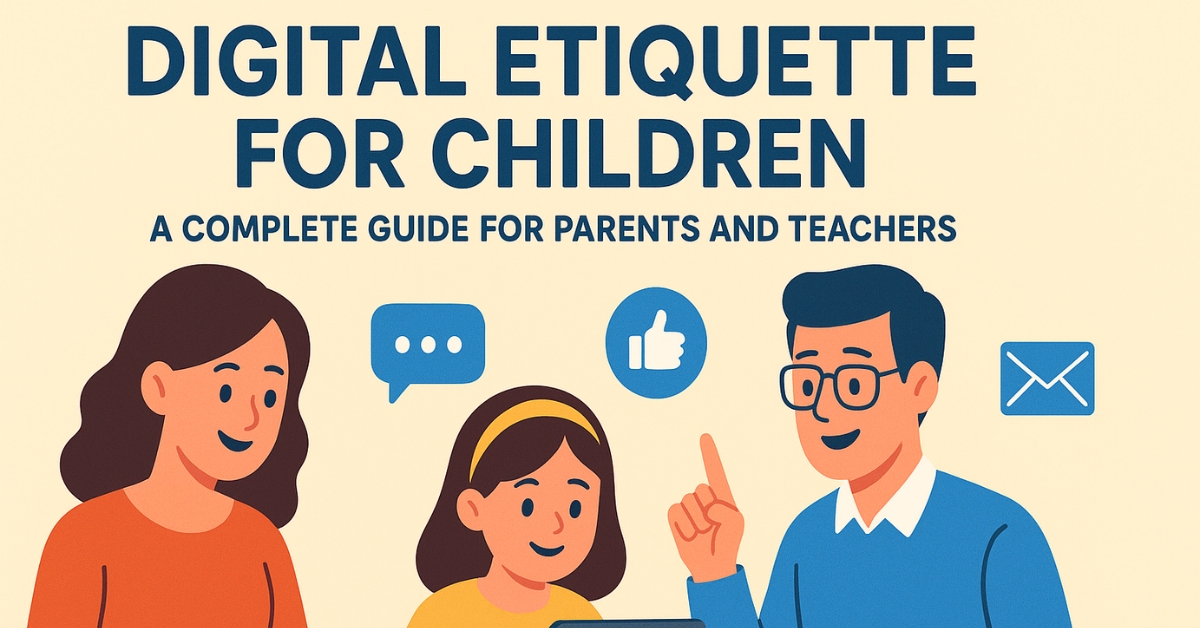Introduction
In our fast-paced digital world, kids are spending a significant chunk of their time online—whether they’re attending virtual classes, gaming, chatting with friends, or diving into social media. While these experiences can be fantastic for learning and personal growth, they also bring their own set of challenges.
One of the key hurdles is teaching children about digital etiquette—essentially, how to behave politely, responsibly, and safely in online environments. Just as we guide kids to say “please” and “thank you” in face-to-face interactions, they also need to learn how to communicate with respect and kindness in the digital realm.
This article will break down what digital etiquette is, why it matters, and the 12 essential rules every child should be aware of. Plus, parents and teachers will find helpful tips on how to instill these values at home and in the classroom, nurturing responsible digital citizens.
What is Digital Etiquette for Children?
Digital etiquette for children, often referred to as netiquette, focuses on teaching kids the proper way to conduct themselves while using technology. It’s all about being polite, respectful, and considerate in various digital spaces, including:
- Online classrooms
- Social media platforms
- Gaming communities
- Messaging apps
- Email or discussion forums
Kids need to realize that there’s a real person behind every screen. Their words, actions, and posts can have a lasting impact—whether positive or negative. By instilling good digital manners early on, we can help them steer clear of conflicts, cyberbullying, and misunderstandings, all while building a positive online identity.
Online Etiquette Rules for Children
Here are some key online etiquette rules that children should keep in mind every day:
Understanding Netiquette for Kids
Netiquette is simply the digital equivalent of good manners. Just as we teach children not to interrupt during face-to-face conversations, they also need to learn how to communicate respectfully online. For instance:
- Using kind words instead of insults.
- Respecting other people’s opinions.
- Avoiding spam in chats or class discussions.
How to Teach Digital Etiquette at Home and School
Kids don’t just pick up online manners on their own; it’s something we need to teach and practice with them. Here are some down-to-earth ways that parents and teachers can help guide them:
- Be a role model: Demonstrate respectful online behavior yourself. Kids tend to mimic adults.
- Create clear rules: Establish family digital guidelines—like no shouting in ALL CAPS or posting without permission.
- Practice together: Role-play different online scenarios (for example, “What would you say if someone disagreed with you?”).
- Discuss mistakes openly: If your child makes a digital blunder, take the time to explain what went wrong and how to correct it.
Teaching should be consistent both at home and in school. With the right support, kids will understand that good digital behavior is just as crucial as good manners in the real world.
Key Rules of Online Etiquette for Kids
Here are 12 essential practices every child should keep in mind:
1 Be polite – Choose your words wisely; remember there’s a real person on the other end.
2 Respect time – Avoid repeating questions or spamming; double-check before you post.
3 Be clear and brief – Skip the long-winded texts; get straight to the point.
4 Stay within context – Keep the conversation focused on the topic at hand.
5 Respect opinions – It’s okay to disagree, but never insult or bully.
6 Be accurate and factual – Share only verified, credible information.
7 Use proper grammar & punctuation – Steer clear of ALL CAPS; it comes off as shouting.
8 Avoid sarcasm – Tone can be tricky to interpret online.
9 Nothing is private – Think before you post; once it’s online, it’s there forever.
10 Respect privacy – Never share someone else’s content without their permission.
11 Be forgiving – Not everyone is a digital whiz; accept apologies graciously.
12 Think before sending – Always take a moment before hitting “Send” or “Post.”
These rules help make online interactions safe, respectful, and meaningful.
Digital Manners Every Child Should Know
When we talk about digital etiquette, it’s not just about the big rules—it’s also about those everyday digital manners that can make a difference. For instance:
- Always greet someone politely before sending a message.
- Make sure not to interrupt during online classes or video calls.
- Use emojis and GIFs wisely—keep it to a minimum and stick to appropriate ones.
- Always express gratitude by saying “thank you” when someone lends a hand online.
By incorporating these small habits into their routine, kids can build a strong digital character.
Online Behavior Norms for Children
Children need to realize that online spaces are just extensions of the real world, and the same norms apply:
- Be kind and respectful to others.
- Steer clear of gossip and bullying.
- Embrace honesty and take responsibility for your actions.
When kids consistently practice these norms, they grow into confident and respectful digital communicators.
Social Media Etiquette for Kids
As kids get older, social media plays a significant role in their lives. Parents should guide them on social media etiquette, including:
- Avoid oversharing: Keep private details like your home address or school name off the internet.
- Think before you post: Ask yourself, “Would I be comfortable if a teacher or grandparent saw this?”
- Don’t fall into the comparison trap: Remember, social media often showcases the highlights of others’ lives—encourage kids not to feel pressured.
- Stay away from negativity: No bullying, rude comments, or harmful jokes.
- Promote positivity: Share content that spreads kindness and lifts others up.
When used responsibly, social media can be a fantastic tool—but it definitely needs some rules and awareness.
Online Safety and Etiquette for Children
Digital etiquette goes hand in hand with online safety. Kids should learn to:
- Keep their passwords safe and never share them with friends.
- Report any cyberbullying or harmful content right away.
- Avoid chatting with strangers online.
- Keep personal photos, videos, and details private.
Good online manners help create a safer internet, while safety rules protect kids from potential risks. They really do complement each other.
Digital Citizenship and Responsibility
The primary goal of teaching digital etiquette is to foster responsible digital citizens.
A good digital citizen embodies the following traits:
- They positively use technology.
- They show respect to others in online environments.
- They think critically before sharing any information.
- They find a balance between screen time and real-life activities.
By embracing digital etiquette and prioritizing online safety, children can establish a positive digital footprint—an asset that will benefit them in their education, careers, and social interactions in the future.
FAQ
Q1: What’s the best way to talk to a child about digital etiquette?
A: Use relatable examples, real-life situations, and role-playing. Keep the conversation upbeat and encouraging, rather than just focusing on the rules.
Q2: Why is it important to teach netiquette to children?
A: It helps kids steer clear of conflicts, shields them from potential risks, and molds them into respectful digital citizens.
Q3: At what age should kids start learning about digital etiquette?
A: As soon as they start using digital devices, typically around ages 5 to 7.
Final Thoughts
Teaching digital etiquette to children goes beyond just avoiding mistakes; it’s about fostering character, respect, and responsibility in our digital world. By guiding kids on how to use technology politely and safely, we set them up to succeed as responsible digital citizens.
Parents, teachers, and communities all have a part to play in this important journey. With the right support, kids can develop into confident individuals who know how to navigate the digital landscape positively.




